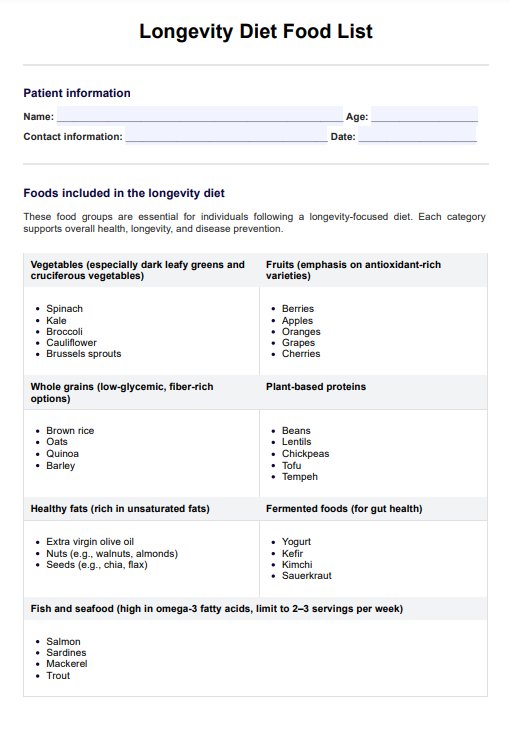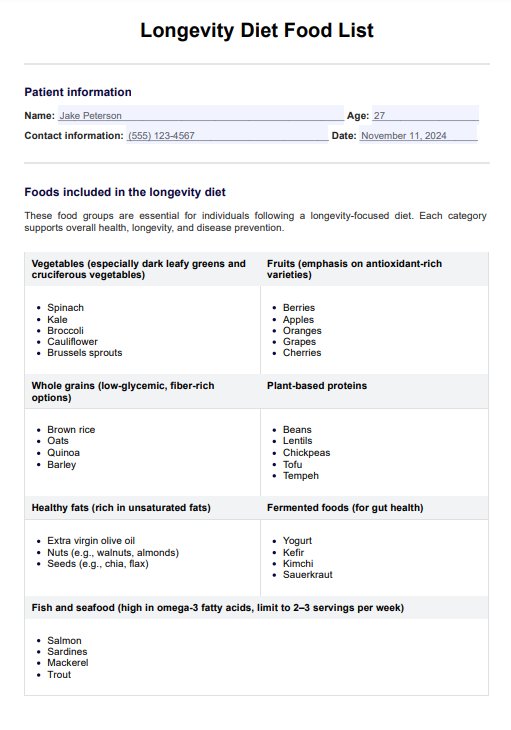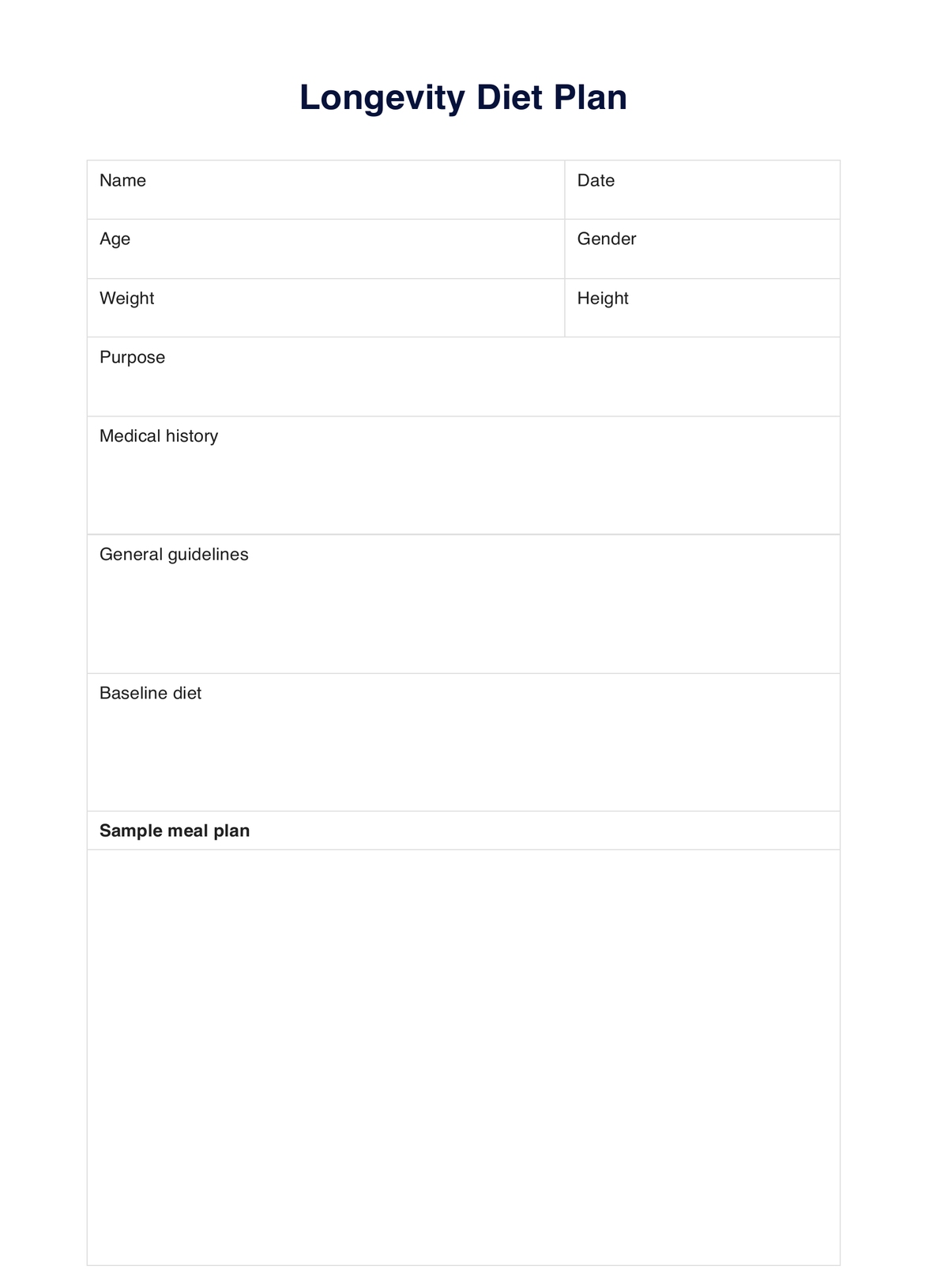Longevity Diet Food List
Help clients explore foods that promote healthy aging with our Longevity Diet Food List Template.


What is the longevity diet?
The longevity diet is a dietary approach that promotes a long and healthy life by emphasizing plant-based eating patterns, healthy habits, and foods that support overall well-being. This diet is built around a foundation of healthy foods such as cruciferous vegetables, whole grains, and legumes, combined with healthy fats like those found in olive oil.
According to Longo & Anderson (2022), a central aspect of the longevity diet is its plant-based diet, incorporating moderate protein intake primarily from sources like fish and legumes. Their study has shown that such a diet is associated with reduced risk of chronic diseases, better blood pressure management, and improved life expectancy. Populations known for their longer life spans, such as those in Okinawa, Sardinia, and Loma Linda (Willcox et al., 2007), follow diets low in animal products, focusing instead on plant-derived proteins. The longevity diet promotes a mid to high carbohydrate intake, which helps preserve muscle mass and prevents frailty, especially in older adults.
Longevity Diet Food List Template
Longevity Diet Food List Example
Foods included in the longevity diet
The Longevity Diet incorporates many healthy foods, promoting long life and overall well-being. This diet emphasizes plant-based eating, including select animal proteins and healthy fats. Below is a breakdown of the key food categories included in the longevity diet according to Longo (2017):
Vegan food items
A diet rich in vegan food items is a cornerstone of the longevity diet, providing essential nutrients and health benefits. Key components include leafy greens, fruits and vegetables, legumes like beans and chickpeas, and fermented foods such as kimchi and sauerkraut. These foods support metabolic health, reduce the risk of metabolic syndrome, and promote vegetable intake, which is essential for heart health
Proteins
Proteins in the longevity diet come primarily from plant-based sources, such as legumes and nut butter, which provide plant protein critical for muscle health. For those who include fish, options like salmon, sardines, and anchovies are recommended due to their high omega-3 fatty acids content. These fatty fish are known to contribute to cardiovascular health and reduce the risk of heart disease.
Unsaturated fats
Unsaturated fats play a crucial role in the longevity diet. Healthy fats such as extra virgin olive oil are consumed generously to support cardiovascular and metabolic health. Nut butter and fatty fish also contribute omega-3 fatty acids, promoting brain health and reducing inflammation. Unlike saturated fats in meat and cheese, these unsaturated options help minimize the risk of heart disease and improve overall health.
Whole grains
Whole grains are an important part of a healthy diet and feature prominently in the longevity diet. Foods like quinoa, brown rice, and whole-wheat bread provide complex carbohydrates that help sustain energy and maintain healthy blood sugar levels. Combining whole grains with low-fat dairy products and plant-based ingredients can create balanced meals for longevity and well-being.
How does our Longevity Diet Food List Template work?
Carepatron’s Longevity Diet Food List Template is designed to assist healthcare professionals in guiding patients toward healthier dietary choices that promote longevity. This step-by-step approach ensures patients understand and can easily adopt longevity-focused eating habits for improved overall health.
Step 1: Access the food list
Healthcare professionals can access the Longevity Diet Food List Template provided in this guide. The list includes recommended foods, portion guidelines, and dietary tips that align with longevity principles, making it easy for practitioners to share accurate and beneficial information with their patients.
Step 2: Introduce the food list to the patient
Begin by introducing the longevity diet food list to the patient, explaining its purpose, and how following it can contribute to a healthier life. Highlight key foods and benefits, such as the emphasis on plant-based options and low saturated fat intake, to create an understanding of the diet’s focus.
Step 3: Provide patient education
Educate the patient on how the food in this list supports long-term health. Discuss the importance of plant-based proteins, healthy fats, and whole grains and their role in reducing risks associated with cardiovascular disease, metabolic syndrome, and other age-related conditions, empowering them to make informed dietary choices.
Step 4: Discuss next steps
Once patients understand the food list, outline the next steps for implementing these dietary changes. Set achievable goals, such as weekly incorporating one new food category, and schedule follow-up appointments to track progress. This approach fosters gradual, sustainable changes aligned with their health goals.
Benefits of using this diet food list
Using this longevity diet food list can provide numerous health benefits by guiding individuals toward balanced, nutrient-rich eating habits. This list is carefully curated to encourage healthier lifestyles, reduce disease risks, and support sustainable weight management. Below are some key benefits of this approach.
Support a healthy weight
The longevity diet food list emphasizes balanced food groups, including dark leafy greens, whole grains, and plant-based proteins, which can help maintain a healthy weight. These nutrient-dense options make it easier to lose weight without restrictive calorie counting or disordered eating habits, promoting a sustainable path to weight management.
Reduce risk factors for chronic disease
Following this food list can significantly reduce risk factors for chronic conditions, including heart disease, colon cancer, and metabolic syndrome. Key items, like dark leafy greens and olive oil, offer anti-inflammatory effects while fasting mimicking diets incorporated into the plan support cellular repair, which helps protect against disease.
Guidance from a registered dietitian
A registered dietitian can assist in personalizing the longevity diet food list to individual needs. Dietitians can help address specific goals, ensure balanced nutrition, and make adjustments to prevent disordered eating patterns. This professional guidance ensures that dietary changes align with individual health goals and are safe and effective.
Balanced food groups for overall health
This diet includes a range of food groups, from fruits and vegetables to healthy fats, which provide essential nutrients. With an emphasis on olive oil consumption and high-fiber vegetables, the list helps support digestion, lower cholesterol, and foster anti-inflammatory effects, all crucial for long-term health.
Reference
Longo, V. (2017, September 21). Longevity diet for adults. https://www.valterlongo.com/daily-longevity-diet-for-adults/
Longo, V. D., & Anderson, R. M. (2022). Nutrition, longevity and disease: From molecular mechanisms to interventions. Cell, 185(9), 1455–1470. https://doi.org/10.1016/j.cell.2022.04.002
Willcox, B. J., Willcox, D. C., Todoriki, H., Fujiyoshi, A., Yano, K., He, Q., Curb, J. D., & Suzuki, M. (2007). Caloric restriction, the traditional Okinawan diet, and healthy aging: The diet of the world’s longest-lived people and its potential impact on morbidity and life span. Annals of the New York Academy of Sciences, 1114(1), 434–455. https://doi.org/10.1196/annals.1396.037
Commonly asked questions
Foods rich in nutrients and antioxidants, like dark leafy greens, berries, nuts, and olive oil, are excellent for longevity. These foods support heart health, reduce inflammation, and lower the risk of age-related diseases.
A good breakfast for the longevity diet might include oatmeal with berries, nuts, and a drizzle of olive oil or chia seeds for healthy fats. Adding leafy greens to a smoothie or a small portion of whole-grain toast with avocado also provides essential nutrients for a healthy start to the day.
Eggs can occasionally be consumed on the longevity diet, particularly for those over 65 who need additional protein. However, the diet primarily focuses on plant-based proteins, so eggs are best used in moderation.
Nuts, seeds, fatty fish, legumes, cruciferous vegetables, and whole grains are associated with longevity. These foods are rich in essential vitamins, minerals, and healthy fats, supporting cellular health and reducing disease risk factors.












































































































